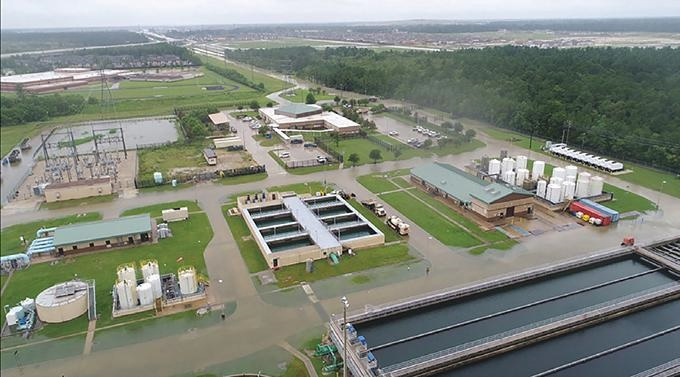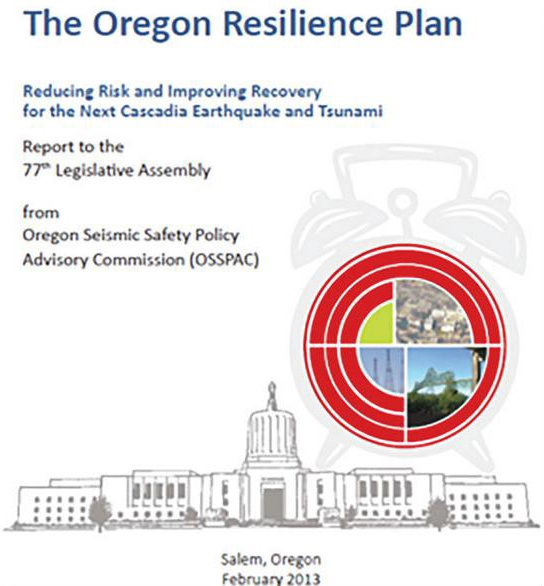Preparing For The Worst
By Lara Kammereck, Kevin Tice, And Josh Miner
No utility wants to enact an emergency plan, but every utility should have one in place.
For many, preparing for a catastrophic event — be it a natural disaster, terrorism, or other major event — is overwhelming. However, it is even more daunting for a city, county, utility district, or public agency whose customers depend on them for essential services. While maintaining the full function of their services, public utilities must work quickly to assess and mitigate the effects of catastrophic events on critical infrastructure such as water supply, electric power, gas and liquid fuels, telecommunications, transportation, and waste disposal with minimal downtime.
Matters are further complicated by the critical infrastructure’s location and present condition. For instance, key infrastructure is often located underground and out of sight, making it difficult to immediately determine the condition of components after an event. Furthermore, when important facilities such as water distribution mains, high-pressure gas mains, and electric power substations are adjacent to aged, weak pipelines, an abrasive event can easily increase the potential for unanticipated accidents. Without proper preparation for these infrastructure systems, service providers cannot serve critical customers with life-saving necessities.
Infrastructure (especially water and wastewater systems) in the U.S. is rapidly aging and growing more insecure. At the same time, the frequency of catastrophic events and our understanding of the impacts are increasing. Further, the demands on our infrastructure are ever-changing and as a result, our infrastructure must adapt to 21st century requirements. Our day-to-day reliance on reliable water and wastewater services is something everyone forgets about until their faucet or toilet does not work. Each minute that passes after an event is on the critical path to restoring service, and it is up to the providing utilities to be ready for the worst possible scenario. This is why critical service providers must increasingly consider resilience in their decision-making and planning efforts.
As defined by the Department of Homeland Security (DHS), infrastructure resilience is:
The ability to reduce the magnitude and/or duration of disruptive events. The effectiveness of a resilient infrastructure or enterprise depends upon its ability to anticipate, absorb, adapt to, and/or rapidly recover from a potentially disruptive event. (Department of Homeland Security National Infrastructure Advisory Council, Critical Infrastructure Resilience Final Report, September 2009.1)
As cities, counties, and districts update their water and wastewater system master plans, resiliency-based planning is becoming a higher priority than ever before. Notably, the state of Oregon has taken the initiative to develop a specific resilience plan for its utilities. In 2011, Oregon adopted House Resolution 3, which directed the Oregon Seismic Safety Policy Advisory Commission to lead and coordinate preparation of a new resilience plan.
Published in 2013, the Oregon Resilience Plan summarizes the science of Cascadia subduction zone earthquakes and tsunamis and estimates their impacts. Additionally, it provides detailed analyses of the existing vulnerabilities within buildings, business communities, transportation, energy, communication, and water/wastewater systems. The plan defines the performance targets that each sector must meet to achieve adequate resilience and includes recommendations for the actions required to meet those targets over the next 50 years.
To supplement the water and wastewater elements in this plan, the Oregon Health Authority (OHA) has also recently required water systems with 300 or more service connections to include a seismic risk assessment and mitigation plan with five-year updates to water system master plans, per OAR 333-061-0060. It is only a matter of time before the state requires this plan requirement for other utilities.

The Houston Northeast Water Treatment Plant, which serves approximately 500,000 residents, approximately two days after it was inundated by the unprecedented flooding brought on by Hurricane Harvey in August, 2017 (drone footage courtesy of City of Houston)
Historically, master planning for water distribution systems, sanitary sewer collection systems, and treatment plants has focused on three main factors: growth and capacity, standards and regulations, and the condition of assets.
Historically, master planning for water distribution systems, sanitary sewer collection systems, and treatment plants has focused on three main factors: growth and capacity, standards and regulations, and the condition of assets. Given these factors, utilities have had to complete the following efforts for master plans:
-
Develop realistic projections for population growth to evaluate existing and future collection systems and their treatment capacity.
-
Collect data that describes the existing collection system’s physical condition and hydraulic capacity.
-
Develop and maintain an up-to-date hydraulic model of the collection system.
-
Identify capital improvements and maintenance projects to support system expansion while optimizing the life of the existing collection system’s assets.
-
Balance capital improvements and maintenance programs to maximize taxpayer investment and provide the level of service that ratepayers expect.
-
Address existing and future regulatory requirements, such as the Government Accounting Standards Board Statement 34 (GASB 34), and the proposed EPA sanitary sewer overflow regulations (cMOM).

“Oregon citizens will not only be protected from life-threatening physical harm, but because of risk reduction measures and pre-disaster planning, communities will recover more quickly and with less continuing vulnerability following a Cascadia subduction zone earthquake and tsunami.” – The Oregon Resilience Plan, seismic resilience goal
Although utilities still must complete these tasks, they must now also incorporate resiliency-based requirements and improvements that will reduce damage to a utility’s infrastructure during a disastrous event. This paper provides an overview of the three major objectives to achieve when resilience planning and discusses how they can fortify every component of a water and wastewater system.
Building The Resilience Plan: Three Major Objectives
Although building a resilient water and wastewater system is imperative, the process takes time: a utility must evaluate the many components of the infrastructure it manages, consider its budget and finances, and prioritize crucial projects identified by risk assessments. That said, the first step in committing to infrastructure resilience is to develop a comprehensive resilience plan.
This plan identifies and prioritizes system-wide improvements needed to increase the resiliency of the system, reduce risk, and shorten recovery time. For instance, water services for fire suppression, first aid, and emergency response are required during or immediately after a catastrophic event. Meanwhile, wastewater systems must protect the community from sewage contamination, health hazards, and disease outbreaks within the first 24 hours. With these needs in mind, a resilience plan prioritizes projects that will reduce the recovery time for the associated risks.
The previously mentioned ORP and the National Institute of Standards and Technology’s (NIST) Community Resilience Planning Guide provide a framework for target recovery times unique to elements of water and wastewater systems. This framework also prioritizes these elements, beginning with water supplies and the “backbone” of the system (infrastructure that supplies critical customers), followed by fire flow and infrastructure that serve emergency supply points, and then eventually restoring the entire system.
The following sections summarize the three major objectives of developing a comprehensive resilience plan.
Objective One
The first objective in resilience planning is to anticipate the types of catastrophic events that may occur, the areas where they could occur, and to confirm the overall system’s level of service (LOS) goals and the infrastructure’s performance levels. Together, these factors provide the framework for a seismic risk mitigation strategy.
The following steps are recommended when first planning for resiliency against different events:
-
Identify hazard scenarios. Establishing high-risk hazard scenarios early allows the utility to assess its facilities for multiple hazards during document reviews and site visits.
-
Update hazard maps. Occasionally, an infrastructure’s site warrants major geotechnical improvements or facility relocation due to hazards, such as seismic hazards from soil liquefaction, lateral spreading, landslides, and ground-shaking. To account for this, all facility evaluations must not only consider structural assessments, but also input from accurate, up-to-date hazard maps.
-
Establish LOS goals. LOS goals guide the utility how to operate the system after an event according to each element’s recovery time and percentage operational (the ORP and NIST guidelines can be referenced for these numbers). LOS goals are key to determining which of the system’s parts are “backbone” and which improvements should be prioritized. If LOS goals are not established early on, the resulting implementation strategy could be overly conservative or overlook key improvements.
-
Establish performance levels. The utility must determine the performance levels of each critical infrastructure under different catastrophic events. These levels provide a guideline when evaluating the structure for what types of improvements are recommended to meet that desired level.

Updated seismic hazard maps can be overlaid with pipe data in GIS to determine the anticipated level of damage caused by a seismic event’s specified intensity. By understanding where existing vulnerabilities lie, the utility can identify where improvements will have the greatest impact on meeting LOS goals.
Objective Two
The second objective is to develop a more comprehensive understanding of the existing system’s condition and to identify pre-event improvements that will restore services sooner after an event. With this understanding, the utility can balance improvement projects with anticipated post-event system repairs while also giving repair crews enough time for operational workarounds to meet the target recovery times developed in the LOS goals.
The following steps are necessary to understanding which improvements are needed and where:
-
Perform facility resilience evaluations. The bulk of this component is evaluating pipelines, pump stations, buildings, and process structures under the identified hazard scenarios. The performance of individual processes at water and wastewater treatment plants determines the overall ability of the facility to treat and move flows through the system.
-
Perform assessment of critical interdependencies. Water and wastewater systems and their associated treatment processes depend on many inputs, including upstream collection systems, water, power, and supplies. These interdependencies will be performed in parallel with the facility evaluations.
Objective Three
The third objective is to develop a capital improvement program (CIP) that incorporates resiliency improvement projects. The CIP identifies and prioritizes different projects (system rehabilitation, replacement, expansion, etc.) that maximize the performance of existing assets and “hardens” the system from a resiliency perspective. While selecting one project over another is difficult, factoring resiliency into the prioritization process can clarify the project sequencing.
The following step is required to solidify the system’s overall resiliency:
- Develop an implementation strategy. This step identifies recommendations that will reduce vulnerabilities and mitigate risk. By combining the elements of the first two objectives into a disaster mitigation and recovery plan, the utility will have a list of prioritized projects with cost estimates allocated into specific implementation phases. This list will ultimately become the basis for a resilience program.
A Future In Resiliency
Looking ahead into the 21st century, utilities in the U.S. must aggressively incorporate resiliency into their water and wastewater systems to defend public health, economic activity, and the environment after any catastrophic event. Using the three objectives in this paper and the steps for developing a resiliency plan, utilities everywhere are encouraged to incorporate resiliency-based projects into their planning efforts to continue providing reliable service during and after a catastrophic event.
About The Authors
 Lara Kammereck, PE, is a senior project manager and vice president at Carollo Engineers. A municipal planning specialist with more than 25 years of experience in the field, she assists water and wastewater clients in developing resiliency assessments, comprehensive plans, alternative analyses, and condition assessment evaluations.
Lara Kammereck, PE, is a senior project manager and vice president at Carollo Engineers. A municipal planning specialist with more than 25 years of experience in the field, she assists water and wastewater clients in developing resiliency assessments, comprehensive plans, alternative analyses, and condition assessment evaluations.
 Kevin Tice, PE, is a utility analyst with Carollo. His experience includes managing water and wastewater master planning projects, developing Level 4 cost estimates for capital improvement programs (CIP), and analyzing the impact of CIPs on utilities’ financial forecasts.
Kevin Tice, PE, is a utility analyst with Carollo. His experience includes managing water and wastewater master planning projects, developing Level 4 cost estimates for capital improvement programs (CIP), and analyzing the impact of CIPs on utilities’ financial forecasts.
 Josh Miner, PE, is a planning engineer for Carollo, experienced with water distribution system modeling, water distribution system resiliency planning, pipeline vulnerability evaluations, wastewater collection systems, water system feasibility studies, and wastewater treatment facilities planning.
Josh Miner, PE, is a planning engineer for Carollo, experienced with water distribution system modeling, water distribution system resiliency planning, pipeline vulnerability evaluations, wastewater collection systems, water system feasibility studies, and wastewater treatment facilities planning.
